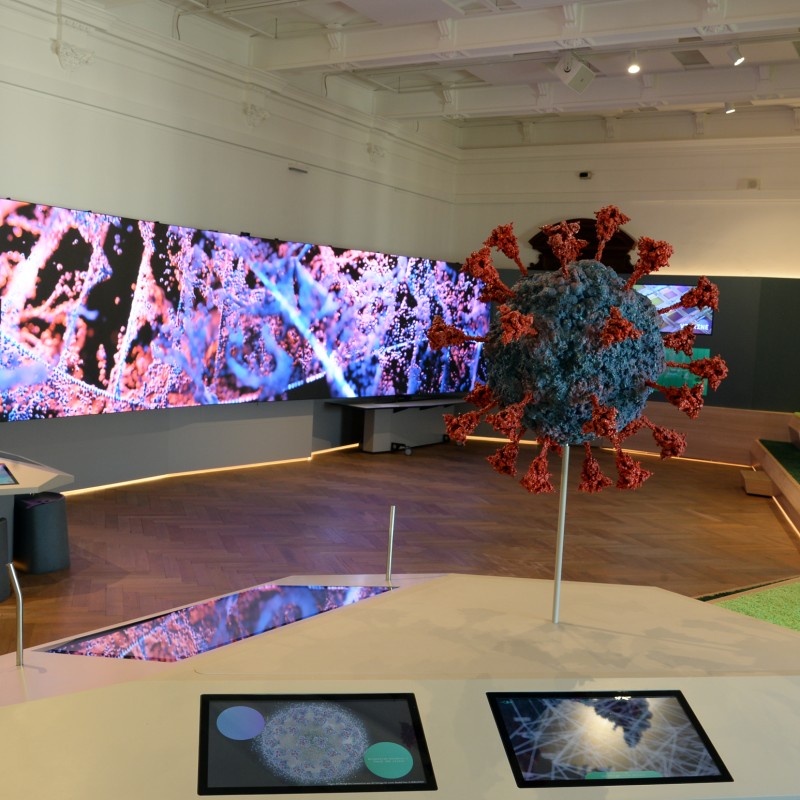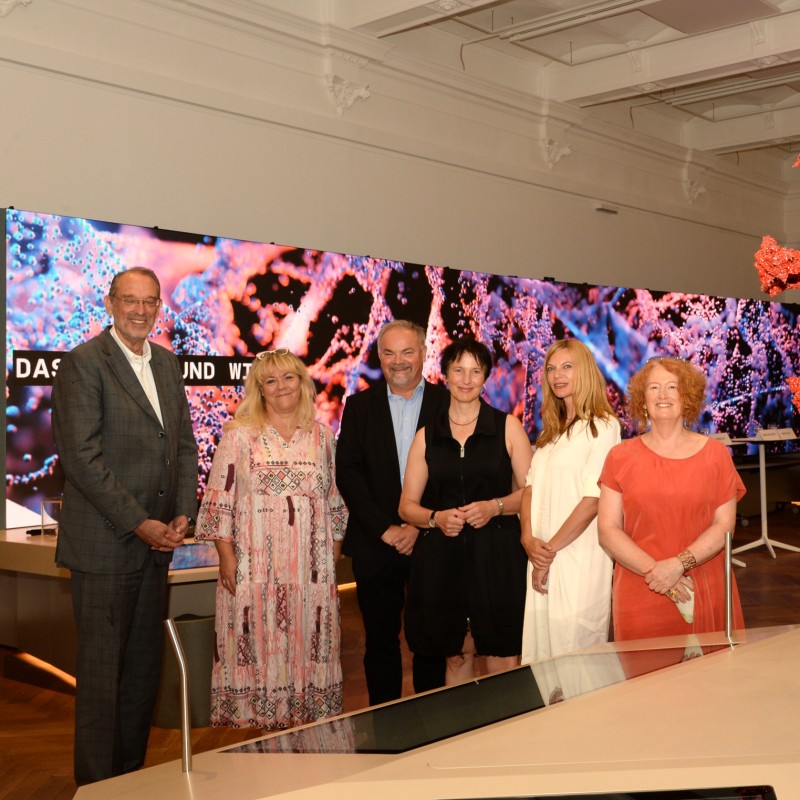Invitation to the Press Conference: “The Virus and Us”
12. July 2023
Where do viruses come from? Since
when have they been in existence on our planet? A new knowledge station at the Natural History Museum (NHM) Vienna answers
questions about viruses and also presents a new virus model – a greatly magnified model of SARS-CoV2, the virus that triggers
Covid infections. Developed and built in cooperation with the IMBA, the Institute for Molecular Biotechnology of the Austrian
Academy of Sciences, the model will be on show on the NHM’s “Deck 50” from 26 July 2023.
Press conference on Tuesday, 25 July 2023, at 10:30 a.m.
Press conference on Tuesday, 25 July 2023, at 10:30 a.m.
The
NHM Vienna and the IMBA are pleased to invite media representatives to a presentation of the new interactive station on Deck
50, to be held on Tuesday, 25 July 2023, at 10:30 a.m.
Venue: Natural History Museum Vienna, Maria-Theresien-Platz, 1010 Vienna, Deck 50
Admission: from 10:00 a.m.
Start: 10:30 a.m.
Programme:
Welcome and introduction
Dr. Katrin Vohland, Director General/CEO of the NHM Vienna
Welcome & contribution of the Austrian Academy of Sciences during the coronavirus pandemic
Prof. Dr. Heinz Faßmann, President of the Austrian Academy of Sciences (ÖAW)
Prof. Dr. Jürgen Knoblich, Scientific Director of the Institute for Molecular Biotechnology of the Austrian Academy of Sciences (IMBA)
The new station “The Virus and Us”
Ines Méhu-Blantar, head of Deck 50, Department of Science Communication, NHM Vienna
The joint project and the integration of a range of different science fields
(With the participation of: Dr. Sabine Eggers, Dr. Karin Macfelda, Mag. Christoph Hörweg, Dr. Sophie Fessl)
Prof. Dr. Karin Macfelda, visiting researcher at the NHM’s Pathological-Anatomical Collection in the Narrenturm
Followed by a visit to the new station “The Virus and Us” and the 1-metre model of SARS-CoV2
The virus and us
The new station on Deck 50 of the NHM Vienna takes a holistic approach to the history of viruses and human beings from early evolution to the recent present:
What is a virus and since when have viruses been around? What role have viruses been playing in shaping life on the planet and are there commonalities between humans and viruses? Why do some viruses make people ill or trigger pandemics, whereas most viruses are vital for human and animal health and ensure a balanced environment? How can virus research help develop new therapies against cancer? And what does the loss of biodiversity have to do with the emergence of new and dangerous diseases?
These are the type of questions addressed by the new station and by “Club Vielfalt”, the NHM Children's University, which is funded by the Federal Ministry of Education, Science and Research (BMBWF).
While we mainly associate viruses with falling ill, the human body is full of viruses that do not necessarily result in disease. The reason is that most viruses hunt for bacteria. Like viruses, bacteria include pathogens and beneficial organisms that are found in every organism, and the viruses in our body help to keep this ecosystem (microbiome) in balance.
Dr Katrin Vohland, Director General/CEO of the Natural History Museum Vienna, explains the rationale behind the station as follows: “We want to make people aware of the important role that viruses and genetic mechanisms have on all organisms. Viral DNA accounts for roughly 60% of the total human DNA mass, for instance.”
SARS-CoV-2 – the trigger of Covid infections and probably the most notorious virus of the recent past – is presented as a greatly magnified model at the station on Deck 50 of the Natural History Museum. At this interactive station, the visitors are also encouraged to provide their own input. Their personal impressions and associations are systematically collected in order to arrive at a comprehensive picture of the most recent pandemic and its effects on all walks of life.
Prof. Dr Heinz Faßmann, President of the Austrian Academy of Sciences: “Research has made a major contribution in fighting the pandemic. Researchers from the Academy of Sciences were involved in the development of several Covid tests at the IMBA, including the gargle tests. Scientists at the IMBA and the neighbouring IMP institute provided central virus variant analyses for the entire country. I am delighted to see that visitors can now observe and experience these achievements and the importance of virus research on Deck 50.”
The station “The Virus and Us” was created jointly by the Natural History Museum Vienna (Department of Anthropology as well as Pathological-Anatomical Collection in the Narrenturm, 3rd Zoological Department, Science Communication and Zoological Preparation), the Medical University of Vienna and the Institute of Molecular Biotechnology of the Austrian Academy of Sciences.
Please register for the press conference by email: presse@nhm-wien.ac.at
Venue: Natural History Museum Vienna, Maria-Theresien-Platz, 1010 Vienna, Deck 50
Admission: from 10:00 a.m.
Start: 10:30 a.m.
Programme:
Welcome and introduction
Dr. Katrin Vohland, Director General/CEO of the NHM Vienna
Welcome & contribution of the Austrian Academy of Sciences during the coronavirus pandemic
Prof. Dr. Heinz Faßmann, President of the Austrian Academy of Sciences (ÖAW)
Prof. Dr. Jürgen Knoblich, Scientific Director of the Institute for Molecular Biotechnology of the Austrian Academy of Sciences (IMBA)
The new station “The Virus and Us”
Ines Méhu-Blantar, head of Deck 50, Department of Science Communication, NHM Vienna
The joint project and the integration of a range of different science fields
(With the participation of: Dr. Sabine Eggers, Dr. Karin Macfelda, Mag. Christoph Hörweg, Dr. Sophie Fessl)
Prof. Dr. Karin Macfelda, visiting researcher at the NHM’s Pathological-Anatomical Collection in the Narrenturm
Followed by a visit to the new station “The Virus and Us” and the 1-metre model of SARS-CoV2
The virus and us
The new station on Deck 50 of the NHM Vienna takes a holistic approach to the history of viruses and human beings from early evolution to the recent present:
What is a virus and since when have viruses been around? What role have viruses been playing in shaping life on the planet and are there commonalities between humans and viruses? Why do some viruses make people ill or trigger pandemics, whereas most viruses are vital for human and animal health and ensure a balanced environment? How can virus research help develop new therapies against cancer? And what does the loss of biodiversity have to do with the emergence of new and dangerous diseases?
These are the type of questions addressed by the new station and by “Club Vielfalt”, the NHM Children's University, which is funded by the Federal Ministry of Education, Science and Research (BMBWF).
While we mainly associate viruses with falling ill, the human body is full of viruses that do not necessarily result in disease. The reason is that most viruses hunt for bacteria. Like viruses, bacteria include pathogens and beneficial organisms that are found in every organism, and the viruses in our body help to keep this ecosystem (microbiome) in balance.
Dr Katrin Vohland, Director General/CEO of the Natural History Museum Vienna, explains the rationale behind the station as follows: “We want to make people aware of the important role that viruses and genetic mechanisms have on all organisms. Viral DNA accounts for roughly 60% of the total human DNA mass, for instance.”
SARS-CoV-2 – the trigger of Covid infections and probably the most notorious virus of the recent past – is presented as a greatly magnified model at the station on Deck 50 of the Natural History Museum. At this interactive station, the visitors are also encouraged to provide their own input. Their personal impressions and associations are systematically collected in order to arrive at a comprehensive picture of the most recent pandemic and its effects on all walks of life.
Prof. Dr Heinz Faßmann, President of the Austrian Academy of Sciences: “Research has made a major contribution in fighting the pandemic. Researchers from the Academy of Sciences were involved in the development of several Covid tests at the IMBA, including the gargle tests. Scientists at the IMBA and the neighbouring IMP institute provided central virus variant analyses for the entire country. I am delighted to see that visitors can now observe and experience these achievements and the importance of virus research on Deck 50.”
The station “The Virus and Us” was created jointly by the Natural History Museum Vienna (Department of Anthropology as well as Pathological-Anatomical Collection in the Narrenturm, 3rd Zoological Department, Science Communication and Zoological Preparation), the Medical University of Vienna and the Institute of Molecular Biotechnology of the Austrian Academy of Sciences.
Please register for the press conference by email: presse@nhm-wien.ac.at
© NHM Wien, Alice Schumacher
v.l.n.r.: Prof. Dr. Heinz Faßmann (Präsident der ÖAW), Prof. Dr. Karin Macfelda
(Gastwissenschafterin in der Pathologisch-anatomischen Sammlung des NHM Wien im Narrenturm), Prof. Dr. Jürgen Knoblich (Wissenschaftlicher
Leiter des Instituts für Molekulare Biotechnologie der ÖAW), Dr. Katrin Vohland (Generaldirektorin NHM Wien), Mag. Ines Méhu-Blantar
(Leiterin Deck 50 im NHM Wien), Mag. Iris Ott (Leiterin Wissenschaftskommunikation NHM Wien)








